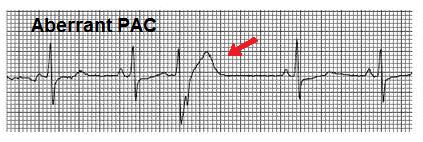 Aberrant conduction describes a beat, such as a PAC (premature atrial contraction) that usually would have a narrow QRS complex. But due to aberrant conduction, the PAC which normally has a narrow QRS, becomes distorted and shows a wide QRS with a funky bundle branch block appearance (see picture below). The beat looks different because the bundle branches that conduct the impulse from the atrium to the ventricles have not fully recovered from the early beat (PAC) because it was conducted early. When a PAC is conducted before the bundle branch have a chance to recover from its refractory period, (usually in the right bundle branch), it causes a delay or blockage while traveling through the bundle branches. The PAC displays a wide QRS bundle branch block pattern that can be confused with a PVC (premature ventricular contraction). 
Why does aberrant conduction ever occur? It is simply because the two bundle branches (BBs) have different length of refractory periods. If an impulse occurs when one BB is still in refractory while the other has recovered from the refractory period, the impulse will conduct through the recovered BB, bypassing the refractory BB: aberrant conduction results. Of course, if an impulse occurs at a time when both BBs have recovered from the refractory period, it will conduct normally, while if both BBs are refractory, it won't conduct at all, producing a non-conducted PAC (see below).>  |
